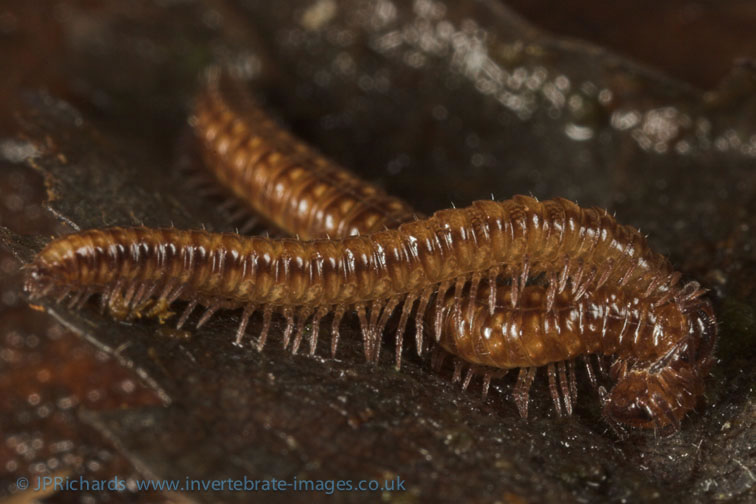Craspedosoma rawlinsii Leach, 1814
Synonyms
- Craspedosoma raulinsii Leach, 1814
- According to McAlpine & Sheer (2018) the specific name should be spelt 'raulinsii' (also see Read & Enghoff, 2023), but the former spelling is currently retained here to avoid confusion.
Status:
- GB IUCN status: Least Concern
- GB rarity status: Nationally Scarce
ID Difficulty
Identification
C. rawlinsii is a rich brown colour a pale pattern and with rounded bumps (paranota) on the sides of the body. Confusion is most likely with some of the recently discovered species (in south Wales); Hylebainosoma nontronensis, Ceratosphys confusa and Turdulisoma spp. All are readily identified by the structure of their respective male gonopods.
Distribution
This species appears to be widely distributed across Britain and Ireland but is not common. Clusters of records from particular regions largely reflect the activity of a specialist recorder in those areas.
C.rawlinsii (including the subspecies alemannicum (Verhoeff, 1910)) has a wide distribution in central Europe but it does not extend into western France (Kime, 2004). Both subspecies are present in Belgium but all British and Irish animals examined have been of the subspecies rawlinsii.
Habitat
Blower (1985) and Kime (2004) considered this species to be primarily a woodland animal but analysis of the habitat data suggests there is a strong association with wetlands. Even in woodland it is associated with microsites which provide the high humidity it prefers (Haacker, 1968). Harding and Jones (1994) noted its presence in East Anglian woodlands subject to considerable summer drought and considered it likely the animal would survive such conditions by burrowing deeply in the light soils. In Belgium, Kime et al. (1992) found the species was associated with soils of high sand and low calcium content. It is also reported from sites with acidic, sandy soils in Switzerland (Pedroli-Christen, 1977) and Germany (Spelda, 1999). Although 80% of British and Irish records for which data were supplied were from non-calcareous soils, a strong association is not evident from the analysis of environmental data due to the small number of such records.
Phenology
The species has been recorded throughout the year but adults are usually found during the winter months.
This species account is based on Lee (2006).
References
Blower, J.G. 1985. Millipedes. Synopses of the British Fauna (New Series), No. 35. London: Linnean Society.
Haacker, U. 1968. Deskriptive, experimentelle und vergleichende Untersuchungen zur Autökologie rhein-mainischer Diplopoden. Oecologia, 1: 87-129.
Harding, P.T. & Jones, R.E. 1994. The occurrence of Craspedosoma rawlinsii Leach (Diplopoda) in East Anglia. Bulletin of the British Myriapod Group, 10, 19-21.
Kime, R.D. 2004. The Belgian Millipede Fauna (Diplopoda). Bulletin de l’Institut royal des Sciences Naturelles de Belgique, Entomologie, 74, 35-68.
Kime, R.D., Wauthy, G., Delecour, F., Dufrene, M. & Drugmand, D. 1992. Distribution spatiale et preferences écologiques chez les Diplopodes du sol. Mémoires de la Société Royal Belge d’Entomologie, 36, 661-670.
Pedroli-Christen, A. 1977. Etude des Diplopodes d’une tourbière du Haut-Jura. Bulletin de la Société Neuchâteloise des Sciences Naturelles, 100, 21-34.
Spelda, J. 1999. Verbreitungsmuster und Taxonomie der Chilopoda und Diplopoda Südwestdeutschlands. Unpublished dissertation, University of Ulm.
Links
MilliBase - Global catalogue of Millipedes: https://millibase.org/aphia.php?p=taxdetails&id=952341





